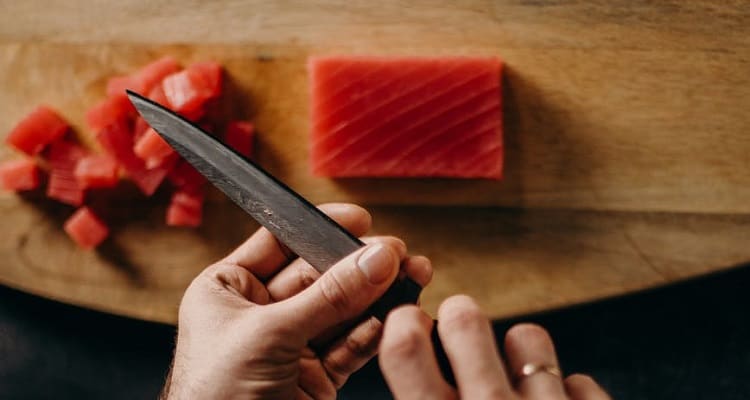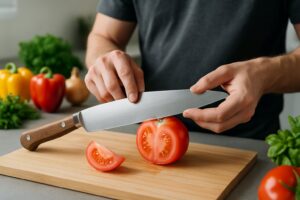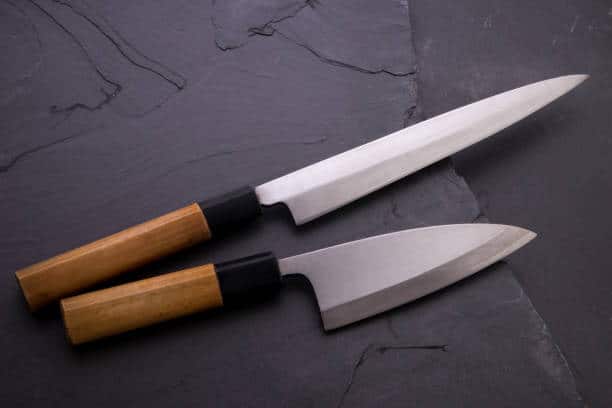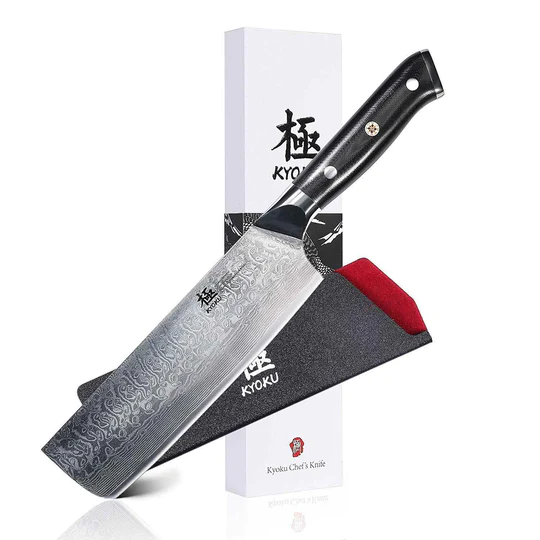


Japanese knives are ideal for precision cutting. They often feature hand crafted steel that maintains sharpness while feeling balanced and light to handle. Favored by professional chefs, these knives are highly specialized and designed for specific tasks such as boning meat, pairing fruits, or cutting vegetables.
With proper knife knowledge and care, these blades are powerhouses in any kitchen due to their unique design and sturdy construction.
The most popular Japanese knives for cutting vegetables, chopping meat, and slicing fruit include:
| Knife Type | Main Use | Blade Shape | Edge Type | Typical Length Inches (cm) |
|---|---|---|---|---|
| 1. Gyuto | All-purpose slicing, chopping | Curved, pointed tip | Double bevel | 7–12" (18–30 cm) |
| 2. Santoku | All-purpose home cooking | Flat edge, sheepsfoot | Double bevel | 5–7" (13–18 cm) |
| 3. Bunka | Versatile chopping and slicing | Wide belly, angle tip | Double bevel | 5–8" (13–20 cm) |
| 4. Nakiri | Chopping vegetables | Rectangular blade | Double bevel | 6.5–7" (16–18 cm) |
| 5. Usuba | Precision vegetable work | Tall, flat edge | Single bevel | 7–8" (18–21 cm) |
| 6. Deba | Butchering and filleting fish | Thick, triangular | Single bevel | 5–8" (12–20 cm) |
| 7. Yo-Deba | Western-style Deba | Heavy, durable | Double bevel | 6.5–8" (16.5–21 cm) |
| 8. Yanagiba | Slicing sashimi (pull cuts) | Long, narrow | Single bevel | 8–14" (21–36 cm) |
| 9. Takohiki | Slicing sashimi, especially octopus | Long, flat tip | Single bevel | 8–13" (21–33 cm) |
| 10. Fuguhiki | Ultra-thin slicing of delicate fish (fugu) | Thin, narrow | Single bevel | 9–12" (24–30 cm) |
| 11. Sujihiki | Slicing meat and fish | Long, narrow | Double bevel | 9–12" (24–30 cm) |
| 12. Honesuki | Boning poultry | Triangular, stiff spine | Single bevel | 6" (15 cm) |
| 16. Hankotsu | Boning poultry | Triangular blade | Single or double | 6" (15 cm) |
| 13. Garasuki | Heavy-duty poultry butchery | Heavy duty | Single bevel | 7" (18 cm) |
| 14. Petty | Peeling, trimming, small prep tasks | Small, narrow | Double bevel | 5–6" (12–15 cm) |
| 15. Kiritsuke | Slicing fish, vegetables (prestige knife) | Flat edge, angled tip | Single bevel | 8–13" (21–33 cm) |
| 16. Mukimono | Decorative carving and precision work | Thin, pointed tip | Single bevel | 6–7" (15–18 cm) |
| 17. Pankiri | Bread knife | Serrated edge | Serrated | 8–10" (20–25 cm) |
The Gyutou is a versatile knife that is akin to the Western Chef’s knife. This all-purpose knife can be used for a wide variety of tasks including cutting meat, fish, and vegetables. These blades are usually right around 8-inches long.
The Gyutou is usually thinner than a western chef’s knife and and it holds a sharper edge. While it’s similar to the Santoku knife, the Gyutou blade has a slight curve to it so it can be used in a rocking motion. The word “Gyutou” translates to “Beef Knife” in English.
Santoku’s name translates to “Three virtues” or “Three purpose” knives. As you might have guessed, the Santoku blade is used to cut meat, vegetables, and fish making it a highly versatile multipurpose blade.
Unlike Gyutou knives, Santoku blades are fully flat. While you can’t use these knives to cut using a rocking motion, these knives are great for chopping in an up and down style cut. The blade is fixed to naturally create thin style cuts. Plus, the wide blade can also be used to scoop vegetables or thinly chopped meat directly into a pan.
Bunka blades have a lot in common with the all-purpose Santoku knife. You can use this knife to cut meat, fish, and vegetables with ease.
The key difference between a Bunka and Santoku knife is that Bunka blades tend to have a finer, more pointed tip that can make it easier to execute fine cuts like a julienne. All in all, a Bunka blade is your best friend for preparing any meal.
Nakiri Knives look very similar to Western Style Cleavers with thick, flat-edged blade design. The single-edged blade design makes this a great knife for cutting through tough vegetables or fruits like melon or squash. The blade can also be used to make precise julienne cuts for stir-fry or other push-cutting tasks.
This knife has no sharp-tip but can cut produce quickly and efficiently for effortless meal preparation. Some knife experts refer to the Nakiri as the westernized version of the Usuba, which is discussed below.
Usuba translates to ‘thin blade’, and this knife certainly live up to the name. This blade is super thin and has a signature single-bevel design. The knife can be incredibly sharp making it well suited for precise, detailed cuts and are used to julienne or slice vegetables.
Usuba knives can take more time to get used to than a Nakiri blade, but they are a powerful blade when used properly. Most Usubas have a square tip, though there are rounded variations depending on the region of origin.
Deba blades are large, single-bevel knives. The Deba is usually used to butcher an entire fish. These knives are very thick at the spine and are usually a bit more weighted than other boning knives. Due to this unique design combination, Deba blades can easily cut through small fish bones while still retaining an extra sharp cutting edge.
The traditional Deba is much sharper than the Yo-Deba variant, though Yo-Deba knives are easier to handle.
Yo-Deba knives are the Western adaptation of the traditional Japanese Deba knife. These blades are heavy, durable, and have a thick spine. Yo-Deba blades come in handy when it comes to meat or fish butchery.
These blades are fully balanced, so they are compatible for both right and left-hand use. Unlike the traditional Deba, Yo-Deba knives are double-beveled and have a more obtuse angle edge.
The Yanagiba knife, sometimes called the Yanagi-ba knife, has a unique, willow shaped blade. This knife is used for making delicate cuts of soft proteins like chicken or roast beef. The blade is also used as a fish slicer and is perfect for finessing and fillets.
These single-edged traditional blades are incredibly sharp and are usually on the long side, with a blade over 10-inches. This high-end knife is known for its popularity in the Sushi space and produces a seamless, clean cut with every use.
If you’re fond of making Sushi, the Yanagiba Knife will make your food preparation a lot easier. The ergonomics and aesthetics of this Japanese knife is truly a winner.
The Takohiki kitchen knife is designed for clean slicing of sashimi, raw fish, and sushi toppings. The Takohiki gets its name from ‘tako’, the Japanese word for octopus.
This knife features a long, straight edge with a square tip and a single bevel edge. The straight edge and blunt tip allow controlled slicing motions and make it easier to transfer the cut fish from the board to a plate without tearing.
This traditional blade is a regional variation of the Yanagiba knife. It is popular in the Kanto region of Honshu, the largest island of Japan.
The Fuguhiki knife is designed for thin slicing of the Japanese Pufferfish. Fugo is a delicacy in Japanese cuisine and it requires precise cuts to avoid lethal toxins in the ovaries and liver.
The single bevel blade shape is similar to the Yanagiba but very thin and narrow. To ensure a razor-sharp performance and near transparent slices the Fuguhiki is typically made of high-carbon steel or stainless steel.
The Sujihiki is a precise knife that is perfect for cutting, slicing, and carving. Sujihiki means ‘muscle or tendon cutter’ which makes perfect sense since these knives are mainly used to slice through ultra-thin cuts of meat or fish.
This long knife is longer than the typical chef or multipurpose blade with a blade up to 12-inches long. The super-thin blade has an excellent edge and is made of a hard cut of steel. While ll knives need to be sharpened regularly, you won’t have to sharpen your Sujihiki blade as much as other knives.
A Honesuki knife has a distinct triangular shape and acts as a very stiff blade. Unlike a western boning knife, this knife doesn’t have a super flexible tip. This makes the knife especially effective when it comes to deboning or cutting through joints of meat or fish.
Its key difference from other boning knives is that its sharp, pointed tip makes it easy for you to ride the blade alongside bones and cartilage. The asymmetrical knife can also function well as a utility knife.
The Hankotsu knife looks like a cross between the Petty and Honesuki knives. This deboning knife can be used on all types of meat, though it’s generally used on hanging poultry. The Hankotsu blade has a thick spine and is not flexible like a western boning knife. This knife is also perfect for cleaning or deboning loins.
The Garasuki Knife is a sturdy, single bevel blade with a pointed tip. This Japanese boning knife is designed for cutting through joints, tendons, and small bones. It is perfect for cutting through cooked chickens, ducks, and turkeys while minimizing meat loss.
The blade is heavier than the Honesuki and is is designed to withstand hard use and repeated cuts against bone without chipping.
The name “Petty” was derived from the word petite meaning small. The Petty blades certainly live up to their name. These tiny utility knives have a 3 to 4-inch blade. Petty knives resemble smaller Gyutou or Chef’s knives in terms of stature and design.
Petty knives have a slightly curved blade making them well-suited for cutting using a rocking motion. These blades are usually used to perform small, detailed tasks like preparing herbs or small fruits and vegetables.
The Kiritsuke is a unique slicer knife and that is commonly used as a slicer blade due to its long, sharp blade construction. The knife has a distinct angled-tip and is traditionally created with a single-beveled design. These blades are perfect for cutting cooked meat or fish.
Kiritsuke knives are incredibly sharp and combine the function of the Yanagiba and Gyutou blades. While these knives are super versatile, they are incredibly difficult to master. In fact, only executive chefs in traditional Japanese culture are permitted to use these special blades.
The Mukimono carving knife is used for intricate knife work, including garnish carving, vegetable shaping, and peeling. This knife is named after the art of Mukimono – the practice of decorative garnishing fruits and vegetables into flowers, fans, and decorative birds. Garnishes are typically prepared for sushi, sashimi, and kaiseki meals.
Smaller than the Usuba, the Mukimono’s single bevel blade has a straight edge with a square chisel tip.
If you ever need to slice bread, you’ll definitely want a Pankiri knife by your side. These knives usually have a long, flexible blade that’s well suited for slicing through layers of cake, bread, and more.
Unlike Western bread knives, Pankiri blades have more of an angle with a unique triangle-like design. The blades are specially serrated so that they will cut through coarse crusts and baked goods with ease, without totally crushing the food in the process.
Traditional Japanese styled blades are single-beveled. This means the blade is only sharpened on one side. Most blades are beveled on the right side for ease of use. Left handed people may need to order a customized Japanese blade to suit their cutting style.
Western blades can be used for a range of tasks whereas Japanese blades are highly specialized and are designed for specific chopping, dicing, and slicing tasks.
Japanese knives can also take a longer time to master. Beginner chefs may be better off learning their trade on standard kitchen knives before using heavier and more specialized Japanese blades.

Japanese knives are usually lighter and sharper than Western knives. This makes the blades well-suited for Japanese style cuisine which can require precise cutting.
With quality knives you get what you pay for. Japanese blades can be more expensive than your run-of-the-mill kitchen blades because they are hand made and use higher quality steel.
You’ll find that many Japanese knives are hand-forged, which comes with an added price tag. The plus side is these blades are well-made and will last you and your family for years to come.
Japanese knives are made out of the top of the line steel for seamless cutting and cooking.
Japanese knives are gorgeous to look at, particularly the Damascus chef blades. You may find that your Japanese blade is engraved, or made with a rare wood handle. These knives may cost a bit extra, but the unique features are worth it.
If you know someone who plans on going to Japan or you have a trip there yourself, should you wait to purchase the knives there? It depends.
Japanese knives can be cheaper in Japan since you won’t have to worry about the costs of shipping or transport. You also get to see and feel the knives in person before purchasing them, which can make it easier for you to purchase a well-fitting blade.
However, if you feel like you could get good use out of your Japanese blades by purchasing them earlier, it may be worth forgoing the cost of shipping. These knives are particularly difficult to master, so time is an essential commodity.
Taking care of your Japanese knife is essential for its performance and longevity. With these simple steps, your knife will stay sharp and ready for use.
Japanese chef knives such as Shun, Tojiro, and Miyabi offer exceptional craftsmanship, sharpness, and balance. These precision knives enhance your cooking experience.
To maintain your Japanese chef knife, sharpen it with a whetstone, clean it by hand with mild soap, and dry thoroughly. Once cleaned, store your knife in a dry place, such as a knife block or magnetic strip.
A sharp Japanese knife can cleanly slice through ingredients. You can check the sharpness by performing a simple paper test or using a sharpening stone to hone the edge.
High-carbon stainless steel offers excellent sharpness, corrosion resistance, and durability. It is a popular blade material in quality Japanese knives.
Japanese Gyuto knives are similar to 8-inch chef knives and offer precision cutting. They are ideal for both professional chefs and home cooks.
The Santoku knife is designed for slicing, dicing, and mincing. The Kiritsuke knife has a more angular blade for precise cuts and intricate slicing tasks.

Knife Buzz offers independent product reviews on a wide range of knives used in the kitchen, home, and outdoors. We make it easy for you to find the right knife at the best price.